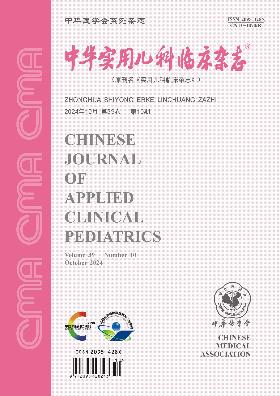川崎病三次复发1例报告
Q4 Medicine
引用次数: 0
摘要
A retrospective analysis was conducted on the clinical data of a child with three relapses of Kawasaki disease admitted to the Cardiovascular Department of the Children's Hospital Affiliated to Xi'an Jiaotong University. The patient, male, 8 years old and 7 months old, first developed Kawasaki disease at the age of 3, and then recurred at intervals of 18, 23, and 25 months, respectively. Each recurrence exhibited the characteristics of complete Kawasaki disease. The first three episodes of Kawasaki disease in the child were treated with intravenous immunoglobulin (IVIG) [2 g/(kg · time)] pulse therapy once, and the fourth episode of Kawasaki disease was treated with IVIG [2 g/(kg · time)] pulse therapy twice. During the second recurrence of Kawasaki disease in the child, abdominal pain was the first manifestation, and exploratory laparotomy was performed. During the surgery, several enlarged fused lymph nodes were found in the ileocecal region. The child experienced incomplete intestinal obstruction again during the third recurrence of Kawasaki disease, with a progressive increase in anti streptococcal hemolysin O. After treatment with anti infection and IVIG shock, the patient was discharged. No recurrence of Kawasaki disease was observed after 0.5 years of follow-up after discharge. It is suggested that for children with a history of Kawasaki disease and a recurrence of prolonged fever, attention should be paid to the possibility of Kawasaki disease recurrence, and some children with Kawasaki disease may be accompanied by incomplete intestinal obstruction.本文章由计算机程序翻译,如有差异,请以英文原文为准。
Case report of Kawasaki disease with three recurrent episodes
对西安交通大学附属儿童医院心血管内科收治的1例川崎病3次复发患儿的临床资料进行回顾性分析。患儿,男,8岁7个月,于3岁首次川崎病发病,其后分别间隔18个月、23个月、25个月再次复发,且每次复发均表现为完全川崎病的特点。患儿前3次川崎病发病予1次静脉用丙种球蛋白(IVIG)[2 g/(kg·次)]冲击治疗,第4次川崎病发病予2次IVIG[2 g/(kg·次)]冲击治疗。其中患儿第2次川崎病复发时以腹痛为首发表现,并行剖腹探查术,术中发现回盲部数枚肿大融合淋巴结。患儿第3次川崎病复发时再次出现不完全性肠梗阻表现,且抗链球菌溶血素O进行性升高,经抗感染及IVIG冲击等治疗后出院。出院后随访0.5年未见川崎病复发。提示对于既往有川崎病病史且再次出现长时间发热患儿,应警惕川崎病复发可能,且部分川崎病患儿可合并有不完全性肠梗阻。
求助全文
通过发布文献求助,成功后即可免费获取论文全文。
去求助
来源期刊

中华实用儿科临床杂志
Medicine-Pediatrics, Perinatology and Child Health
CiteScore
0.60
自引率
0.00%
发文量
14243
期刊介绍:
Chinese Journal of Applied Clinical Pediatrics ( semi-monthly ) is a core journal of paediatrics under the supervision of China Association for Science and Technology, sponsored by Chinese Medical Association and undertaken by Xinxiang Medical College. Founded in 1986, it is openly circulated both at home and abroad. The journal has several columns, such as Expert Forum, Experimental Research and Paediatric Surgery, which are mainly for paediatric medical workers and medical researchers in hospitals. Its purpose is to reflect the new theories and technologies in paediatric medicine and scientific research at home and abroad, and to promote academic exchanges.
Chinese Journal of Applied Clinical Pediatrics is a source journal of China Science Citation Database (CSCD), a core journal of Peking University, a source journal of Chinese science and technology paper statistics (China Science and Technology Core Journals), a core academic journal of RCCSE, a high-quality scientific and technical journal of China, a high-quality scientific and technical journal of China Association for Science and Technology, and a high-quality scientific and technical journal of China Biomedical Science and Technology Association. We have been published in China Biomedical Literature Database (SinoMed), China Knowledge Network, Wanfang Data Knowledge Service Platform, China Academic Journal Abstracts, Scopus Database, Chemical Abstracts (USA), Japan Science and Technology Agency (JSTA) Database, Copernicus Abstracts (Poland), Abstracts of the Centre for Agricultural and Biological Sciences (CABS) of the United Kingdom, Cambridge Scientific Abstracts ProQuest Database, WHO Medical Journal of the Western Pacific Region (WMPR), and WHO Medical Journal of the Western Pacific Region (WMPR) of the United States. We have been included in dozens of authoritative databases at home and abroad, such as WHO Western Pacific Region Index of Medicine (WPRIM), Ullrich's Guide to Periodicals, and so on.
 求助内容:
求助内容: 应助结果提醒方式:
应助结果提醒方式:


